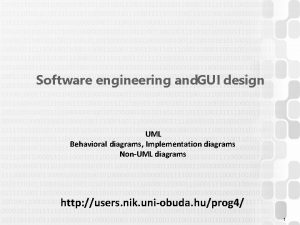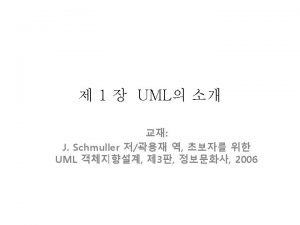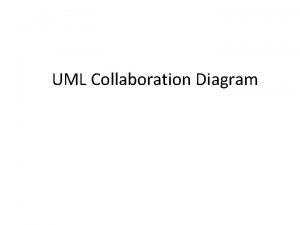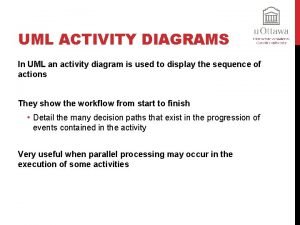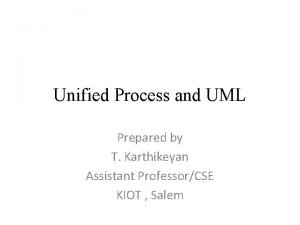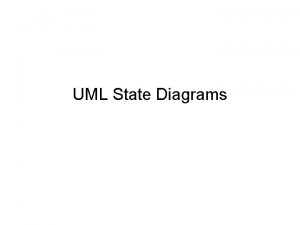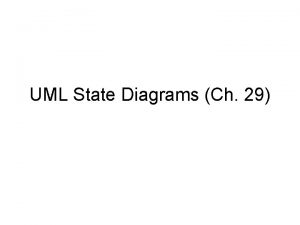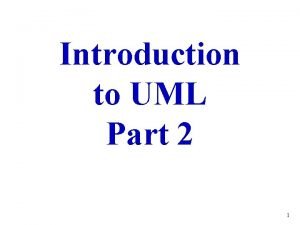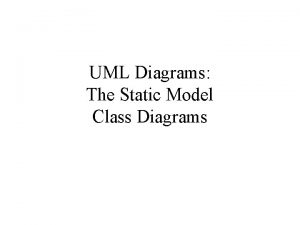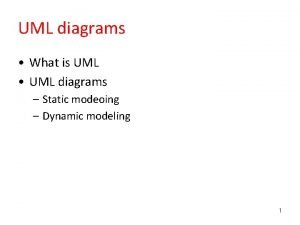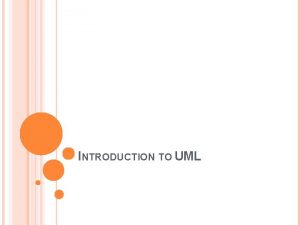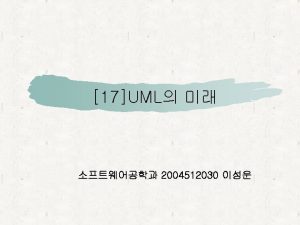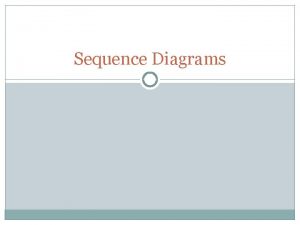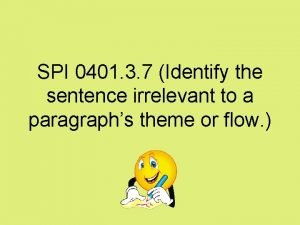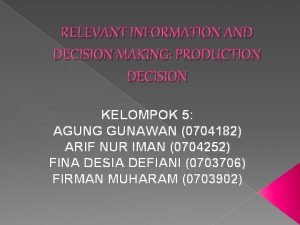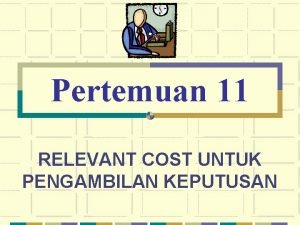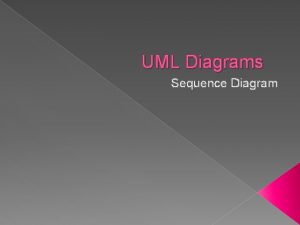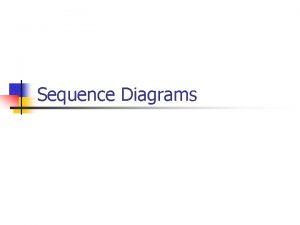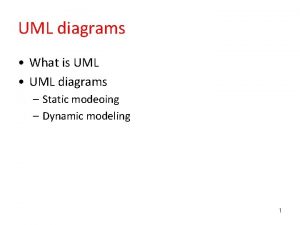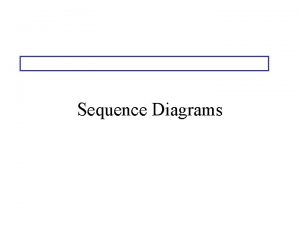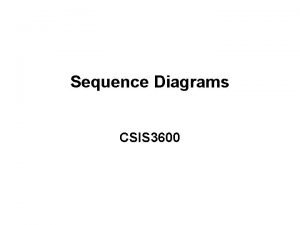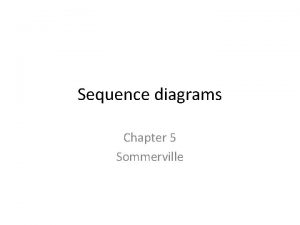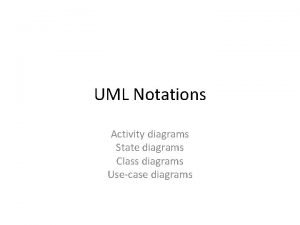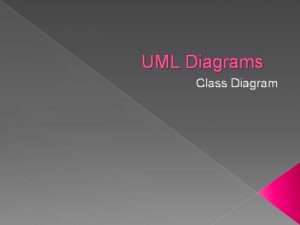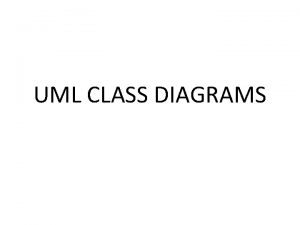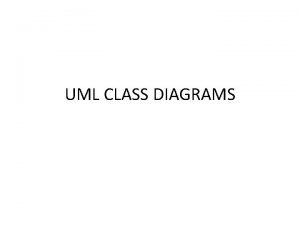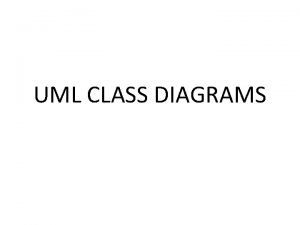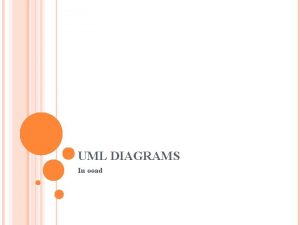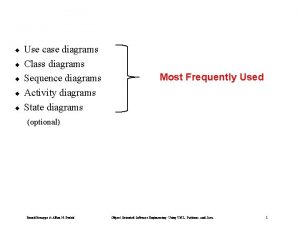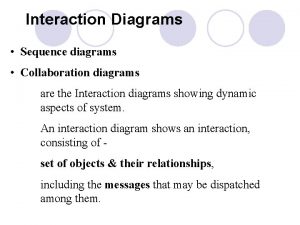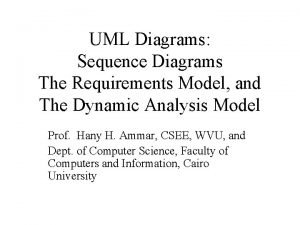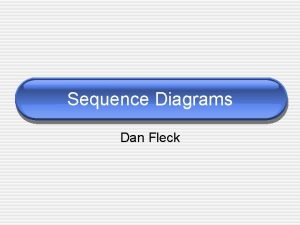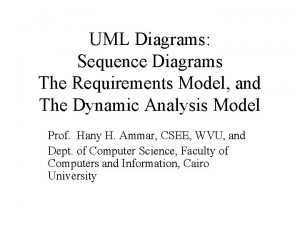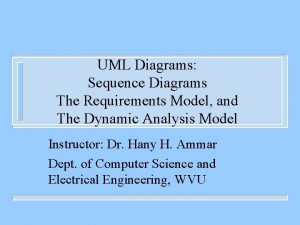Sequence Diagrams UML Sequence Diagrams Relevant Reading UML























- Slides: 23

Sequence Diagrams UML Sequence Diagrams Relevant Reading: UML Distilled, Third Edition M. Fowler

Topics covered Sequence Diagrams A First Look at Sequence Diagrams Objects Messages Control Information Examples 2 Sequence Diagrams

Sequence Diagrams sequence diagram: an "interaction diagram" that models a single scenario executing in the system perhaps 2 nd most used UML diagram (behind class diagram) A series of diagrams describing the dynamic behavior of an object-oriented system. A set of messages exchanged among a set of objects within a context to accomplish a purpose. . 3 Sequence Diagrams

Input to sequence diagram? Often used to model the way a use case is realized through a sequence of messages between objects. use cases -> sequence diagram 4 Sequence Diagrams

Sequence Diagrams (Cont. ) The purpose of sequence diagrams is to: Model interactions between objects Assist in understanding how a system (a use case) actually works Verify that a use case description can be supported by the existing classes Identify responsibilities/operations and assign them to classes 5 Sequence Diagrams

A First Look at Sequence Diagrams Illustrates how objects interacts with each other. Emphasizes time ordering of messages. Can model simple sequential flow, branching, iteration, recursion and concurrency. 6 Sequence Diagrams

A Sequence Diagram member: Library. Member book: Book Copy borrow(book) ok = may. Borrow() [ok] borrow(member) 7 Sequence Diagrams set. Taken(member)

A Sequence Diagram X-Axis (objects) member: Library. Member borrow(book) Y-Axis (time) 8 ok = may. Borrow() message [ok] borrow(member) condition Sequence Diagrams : Book Copy book: Book Life Line set. Taken(member) Object Activation box

Key parts of a sequence diag. participant: an object or entity that acts in the sequence diagram starts with an unattached "found message" arrow message: communication between participant objects the axes in a sequence diagram: horizontal: which object/participant is acting vertical: time (down -> forward in time) 9

Sequence diag. from use case 10

Representing objects squares with object type, optionally preceded by object name and colon write object's name if it clarifies the diagram object's "life line" represented by dashed vert. line 11

Messages (Cont. ) A message is represented by an arrow between the life lines of two objects. Self calls are also allowed The time required by the receiver object to process the message is denoted by an activation-box. A message is labeled at minimum with the message name. Arguments and control information (conditions, iteration) may be included. 12 Sequence Diagrams

Return Values Optionally indicated using a dashed arrow with a label indicating the return value. Don’t model a return value when it is obvious what is being returned, e. g. get. Total() Model a return value only when you need to refer to it elsewhere, e. g. as a parameter passed in another message. Prefer modeling return values as part of a method invocation, e. g. ok = is. Valid() 13 Sequence Diagrams

Messages between objects message (method call) indicated by horizontal arrow to other object write message name and arguments above arrow dashed arrow back indicates return different arrowheads for normal / concurrent (asynchronous) methods 14

Lifetime of objects creation: arrow with 'new' written above it notice that an object created after the start of the scenario appears lower than the others deletion: an X at bottom of object's lifeline Java doesn't explicitly delete objects; they fall out of scope and are garbage-collected 15

Object Creation An object may create another object via a <<create>> message. Preferred : A : B <<create>> Constructor 16 Sequence Diagrams : A <<create>> : B

Object Destruction An object may destroy another object via a <<destroy>> message. An object may destroy itself. Avoid modeling object destruction unless memory management is critical. : A : B <<destroy>> 17 Sequence Diagrams

Indicating method calls activation: thick box over object's life line; drawn when object's method is on the stack either that object is running its code, or it is on the stack waiting for another object's method to finish nest to indicate recursion Activation Nesting 18

Indicating selection and loops frame: box around part of a sequence diagram to indicate selection or loop if -> (opt) [condition] if/else -> (alt) [condition], separated by horiz. dashed line loop -> (loop) [condition or items to loop over] opt [balance <>0] alt [balance < 100. 00] [balance>= 100. 00] loop 19 [balance < 0]

linking sequence diagrams if one sequence diagram is too large or refers to another diagram, indicate it with either: an unfinished arrow and comment a "ref" frame that names the other diagram when would this occur in our system? 20

Example sequence diagram 21

Sequence Diagram for ATM Machine 22 Sequence Diagrams

Hospital Management System 23 Sequence Diagrams
 While reading activities
While reading activities The interaction diagrams, use case diagrams are called as
The interaction diagrams, use case diagrams are called as An activity diagram is a static model.
An activity diagram is a static model. Uml stands for
Uml stands for Static diagrams in uml
Static diagrams in uml Uml
Uml Uml wikipedia class diagram
Uml wikipedia class diagram Collaboration diagram
Collaboration diagram Uml 2 activity diagram
Uml 2 activity diagram Objectives of gym management system
Objectives of gym management system Pos uml diagrams
Pos uml diagrams State diagrams uml
State diagrams uml Pos uml diagrams
Pos uml diagrams Use case diagram for hospital reception system
Use case diagram for hospital reception system Building block of uml
Building block of uml Static class diagram
Static class diagram What is class diagram
What is class diagram Structural view in uml
Structural view in uml Uml diagram
Uml diagram Sequence diagram example
Sequence diagram example What are irrelevant sentences
What are irrelevant sentences Decision making and relevant information
Decision making and relevant information Relevant cost adalah
Relevant cost adalah Steps in decision making
Steps in decision making





